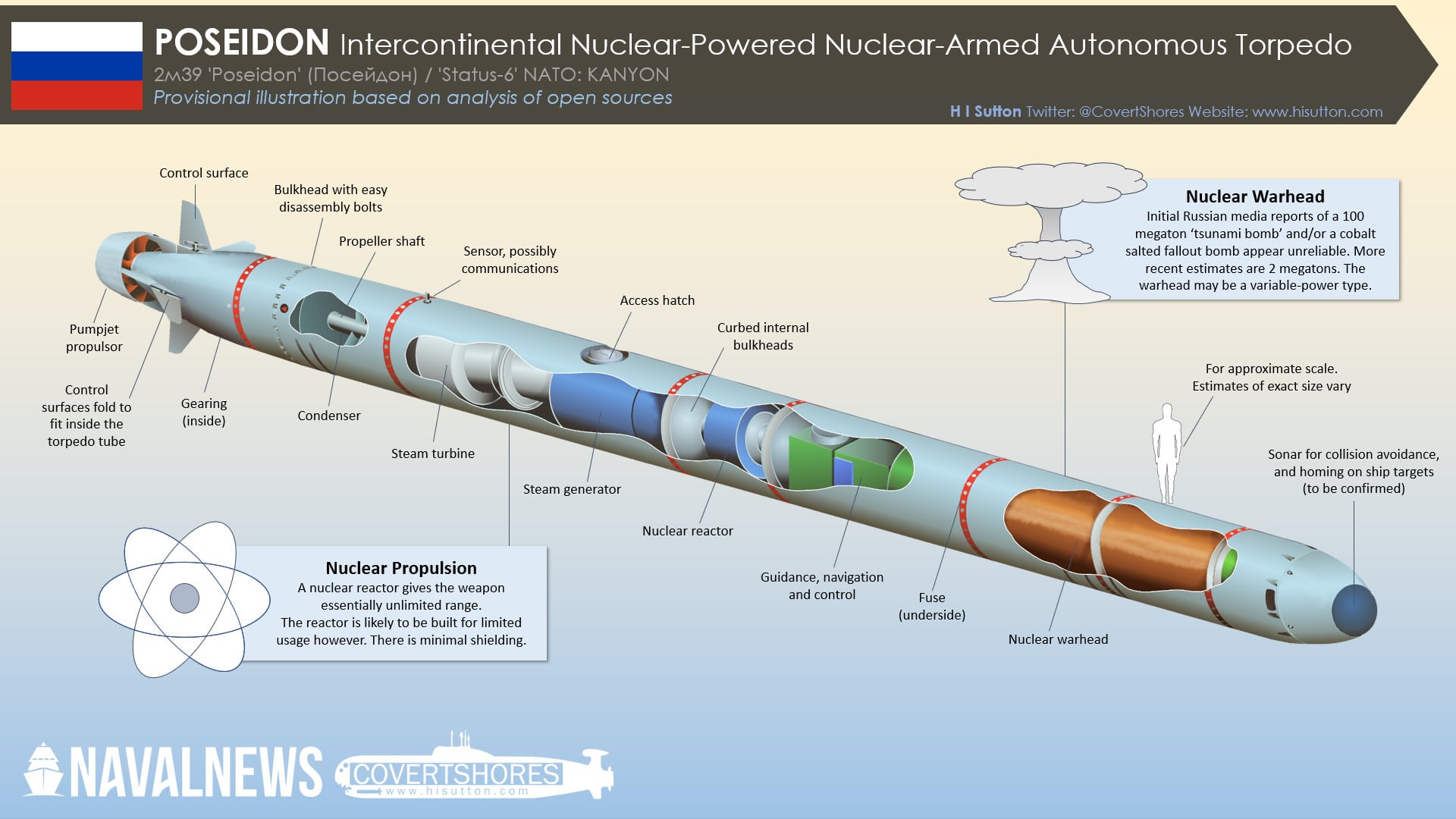
Vladimir Putin discusses the successful test of the 2M39 Poseidon missile. – Russia TV
Published October 31, 2025
⚙️ A New Depth in Nuclear Power
Russia has announced the successful test of its nuclear-powered unmanned underwater vehicle, the 2M39 Poseidon, marking what President Vladimir Putin described as a “historic step” in military technology. The announcement, reported by Fox News, The Gateway Pundit, and Daily Mail, revealed that the Poseidon operated on its nuclear reactor for the first time — a breakthrough that could reshape the future of strategic deterrence.
According to Moscow’s statement, the test was launched from a specially modified submarine, where the Poseidon’s miniature nuclear reactor was activated and ran autonomously for a set duration. Putin boasted that the reactor was “100 times smaller” than those used in standard submarines, yet “significantly more powerful,” with the capability to carry a warhead exceeding the destructive potential of the Sarmat intercontinental missile.
The Kremlin portrayed the test as proof of Russia’s scientific superiority and its ability to defy Western sanctions and deterrence strategies.
🌊 What Is the Poseidon?
The Poseidon — known in NATO classification as “Kanyon” — is designed as a nuclear-powered, nuclear-armed underwater drone. It is reportedly capable of traveling intercontinental distances at great depths and high speeds while avoiding detection by conventional sonar systems.
Early intelligence leaks suggest the vehicle measures approximately 20 meters long, weighs around 100 tons, and can be launched from submarines such as the K-329 Belgorod. Its supposed mission: to strike coastal targets, naval bases, or even trigger “radioactive tsunamis” capable of devastating entire regions.
Western experts caution that many of these claims remain unverified. Yet, even the possibility of such a system changes how military planners and defense analysts think about nuclear deterrence.


2M39 Poseidon — Russia’s Unmanned Nuclear-Underwater Vehicle
 Implications
Implications
⚔️ Military Implications
-
A New Category of Nuclear Weapon
Poseidon represents an entirely new class of deterrent — a nuclear-powered, nuclear-armed underwater drone. It can theoretically travel intercontinental distances undetected, operating for months underwater thanks to its onboard reactor.-
This undermines traditional missile defense systems, which are designed to intercept ballistic or cruise missiles, not underwater vehicles.
-
If proven operational, it effectively creates a “fourth leg” to the nuclear triad (land, air, sea — now unmanned sea).
-
-
First-Strike and Second-Strike Dynamics
-
Poseidon is primarily seen as a second-strike or “revenge” weapon — meant to ensure retaliation even if Russia’s other nuclear forces are destroyed.
-
However, its slow but stealthy nature could also tempt its use as a psychological first-strike threat, able to target coastal cities like New York, London, or Los Angeles.
-
-
Escalation Risk
-
The ambiguity of Poseidon’s deployment — is it armed or just being tested? — increases tension.
-
If NATO detects unusual submarine activity, any misinterpretation could lead to accidental escalation.
-
🌍 Geopolitical Implications
-
Challenge to Western Deterrence Doctrine
Russia’s test directly challenges the credibility of U.S. and NATO deterrence systems. Washington and its allies now face pressure to develop counter-UUV detection technologies, expanding the arms race underwater. -
Putin’s Message to the West
Coming amid strained relations and sanctions, the timing is symbolic. It reinforces Putin’s image domestically as defying Western pressure and reasserting Russia’s military prowess.-
The Daily Mail noted that Putin showcased the test “in defiance of Trump’s warnings” — suggesting a deliberate act of strategic signaling.
-
This echoes Cold War-style brinkmanship, where displays of technological might were used to command geopolitical leverage.
-
-
Impact on Arms Control
-
Poseidon falls outside current nuclear treaties, such as New START, because it’s neither a missile nor a bomber.
-
Its existence complicates future arms control negotiations, potentially derailing any U.S.–Russia or global nuclear limitation talks.
-
☢️ Environmental and Humanitarian Implications
-
“Radioactive Tsunami” Scenario
Russian sources have described Poseidon as capable of carrying a warhead large enough (reportedly up to 100 megatonnes) to trigger a massive underwater explosion — generating a radioactive tsunami capable of flooding and contaminating coastal areas for decades. -
Nuclear Contamination Risk
-
A reactor-powered drone at sea introduces grave risks. A malfunction, loss, or accident could lead to long-term oceanic radiation leakage.
-
If one were ever destroyed underwater, it could become a “nuclear Chernobyl of the deep.”
-
-
Moral and Ethical Fallout
-
The very concept of an autonomous nuclear weapon challenges global norms.
-
It raises profound ethical questions about AI-driven or unmanned nuclear systems — and who bears accountability if such a weapon malfunctions or is used.
-
🧭 Strategic and Long-Term Implications
-
Acceleration of the Underwater Arms Race
The Poseidon test will likely push the U.S., U.K., and China to pursue similar underwater deterrents — sparking a new underwater Cold War. -
Shift in Maritime Strategy
-
Future naval operations will increasingly focus on deep-sea surveillance, anti-drone sonar systems, and submarine fortification.
-
Nations with long coastlines (like the U.S. and Japan) must now factor in deep-sea nuclear threats, not just airborne ones.
-
-
Psychological Deterrence and Propaganda Value
-
Whether or not fully operational, Poseidon serves as a psychological weapon — a symbol of unstoppable Russian capability.
-
Its announcement boosts internal morale and signals to adversaries that Russia still leads in “superweapon” innovation.
-
 Overall Takeaway:
Overall Takeaway:
The successful test of Russia’s 2M39 Poseidon marks a turning point in modern warfare — not only in technology, but in the psychology of global deterrence. Whether or not its full capabilities are as advanced as Moscow claims, the mere existence of a nuclear-powered, unmanned underwater drone redefines what nations must prepare for in the decades ahead.
It underscores the reality that nuclear competition has moved beyond land-based silos and aerial bombers into a shadowy, autonomous realm beneath the oceans. The Poseidon is as much a weapon of fear as of force, a reminder that technological ambition and strategic desperation can converge in dangerous ways.
As global powers react, the world faces a choice: pursue yet another arms race in the depths of the sea, or revive serious dialogue to prevent such weapons from becoming the new face of deterrence. The test may prove a triumph for Russian engineering — but it is also a warning siren for humanity’s fragile balance between defense and destruction.
SOURCES: THE GATEWAY PUNDIT – Russia Successfully Tests Unmanned Underwater Vehicle 2M39 Poseidon – Capable of Triggering Radioactive Tsunamis
FOX NEWS – Putin hails successful test of nuclear-powered underwater torpedo
DAILYMAIL ONLINE – Putin boasts ‘unstoppable’ Poseidon underwater nuclear drone ‘capable of creating radioactive tsunamis’ has been successfully tested – defying Trump’s warning over nukes





Be the first to comment